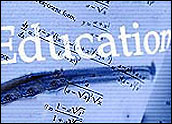
Robotics, which has played a longstanding role in industrial applications, has finally entered the classroom in the form of applications for disabled students. It’s a trend that could move beyond special needs and into the education mainstream.
Gallaudet University, a school for the deaf and hard of hearing, recently added Anystream’s Apreso Classroom, which captures lectures and makes them available online for students to download and review.
Gallaudet’s goal is to improve comprehension and address the challenges faced by the 10 percent of its freshman class who are new to sign language.
“We believe lecture-capturing technology will be as common as LCD projectors within five to 10 years, because the benefits are so abundant and obvious,” Mark Jones, vice president of education products for Anystream, told TechNewsWorld. “We have optimized versions of our software for the visually impaired as well, so they can use a screen reader to read it. Accessibility is essential to serving higher education.”
Technology With a Twist
Other universities have implemented Apreso Classroom — but at Gallaudet, it’s the robotics that gives the technology a futuristic spin. A robotic camera tracks signed interactions occurring in the classroom. Those interactions become closed captioned so that the students who are new to sign language can develop their communication skills.
“Apreso’s closed captioning provides our new signers the invaluable opportunity to view video of their professors presenting course content paired with captions, ensuring the comprehension and retention of course materials while their sign language skills develop,” said Gallaudet’s eLearning Manager Earl Parks.
Apreso Classroom can be scheduled to run automatically, so professors don’t need to spend much time learning how to operate the system or alter the way they teach, Jones said.
Specifically, the software captures and synchronizes the professor’s voice with projected visual aids, a la PowerPoint, to students in the classroom. The software generates an interactive, indexed, Web-based version of the lecture and posts it to university Web sites. Apreso also offers a podcasting solution that lets students listen to lectures via iTunes U or iPods.
Assistive Technology Is Booming
The education industry’s technology spend is growing steadily. In the kindergarten through 12th grade (K-12) sector, total IT spending in 2006 is expected to reach US$5.4 billion; it will climb to $6.3 billion by 2010, a 3.7 percent compound annual growth rate, Datamonitor predicts.
The higher education sector nearly mirrors those numbers, despite the comparatively lower number of students. Total IT spending reached $5.1 billion in 2006, with a CAGR of 4.1 percent, Datamonitor reports. Total spending is expected to reach $6 billion by 2010.
Assistive technology — such as Apreso Classroom — is a niche market that is growing rapidly, thanks in part to the requirements of the Individuals with Disabilities Education Act (IDEA), said Nicole Engelbert, a senior analyst of public sector technology at Datamonitor.
President Clinton signed IDEA in 1997. Many of its provisions explicitly recognize assistive technology devices and services as a means by which students can fully participate in and benefit from educational opportunities.
“Lecture-capture technology is the fastest-growing solution subsegment in higher education today,” Engelbert told TechNewsWorld. “Very large players like Anystream are repackaging existing technologies to address the needs of students with disabilities. So, you see speech recognition software being used more to help support students who need certain accommodations.”
Anystream’s timing is right, Engelbert added. Most college students are up on technology to the point where they use MP3 players and are familiar with podcasting, blogging and video streaming. That makes for a good marriage of technology and higher education needs.
Going Mainstream
Assistive technology serves its market well but could also play a role in mainstream education, according to Don Knezek, CEO of the International Society for Technology in Education.
“Assistive technologies help students with special needs but may also be able to help students who are poor performers or have some special learning style,” Knezek told TechNewsWorld. “There is a tremendous, positive feeling toward assistive technologies in the general education technology community.”
Apreso is already catering to Harvard, MIT and Case Western, among other top-tier universities. Along with Anystream, Sonic Foundry’s Media Site and Lectopia’s iLecture compete for a piece of this growing market.
“When a student goes to class, they usually sit with their head down, writing notes, trying to capture everything that the faculty member says so they can pass the test,” Jones said. “Now, you can [preserve] the record of what happens in the class, so they can go to class to listen, ask questions and interact, then log onto the Web later to review the class. It’s a better model.”





















































